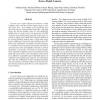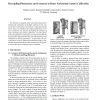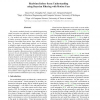ICCV
2011
IEEE
13 years 2 months ago
2011
IEEE
Adaptive tracking-by-detection methods are widely used in computer vision for tracking arbitrary objects. Current approaches treat the tracking problem as a classification task a...
ICCV
2011
IEEE
13 years 2 months ago
2011
IEEE
Optical flow estimation is a fundamental and ill-posed problem in computer vision. To recover a dense flow field, appropriate spatial constraints have to be enforced. Recent ad...
ICCV
2011
IEEE
13 years 2 months ago
2011
IEEE
In recent years, depth cameras have become a widely available sensor type that captures depth images at realtime frame rates. Even though recent approaches have shown that 3D pose...
ICCV
2011
IEEE
13 years 2 months ago
2011
IEEE
In this paper, we propose a physically-based dynamical model for tracking. Our model relies on Newton’s second law of motion, which governs any real-world dynamical system. As a...
ICCV
2011
IEEE
13 years 2 months ago
2011
IEEE
In this paper we propose a new method for the simultaneous segmentation and 3D reconstruction of interest point based articulated motion. We decompose a set of point tracks into r...
ICCV
2011
IEEE
13 years 2 months ago
2011
IEEE
We introduce a spatially dense variational approach to estimate the calibration of multiple cameras in the context of 3D reconstruction. We propose a relaxation scheme which allow...
ICCV
2011
IEEE
13 years 2 months ago
2011
IEEE
We present a method whereby an embodied agent using visual perception can efficiently create a model of a local indoor environment from its experience of moving within it. Our me...
ICCV
2011
IEEE
13 years 2 months ago
2011
IEEE
As a recently proposed technique, sparse representation based classification (SRC) has been widely used for face recognition (FR). SRC first codes a testing sample as a sparse lin...
ICCV
2011
IEEE
13 years 2 months ago
2011
IEEE
Facial micro-expressions are rapid involuntary facial expressions which reveal suppressed affect. To the best knowledge of the authors, there is no previous work that successfully...
ICCV
2011
IEEE
13 years 2 months ago
2011
IEEE
Progress in action recognition has been in large part due to advances in the features that drive learning-based methods. However, the relative sparsity of training data and the ri...



